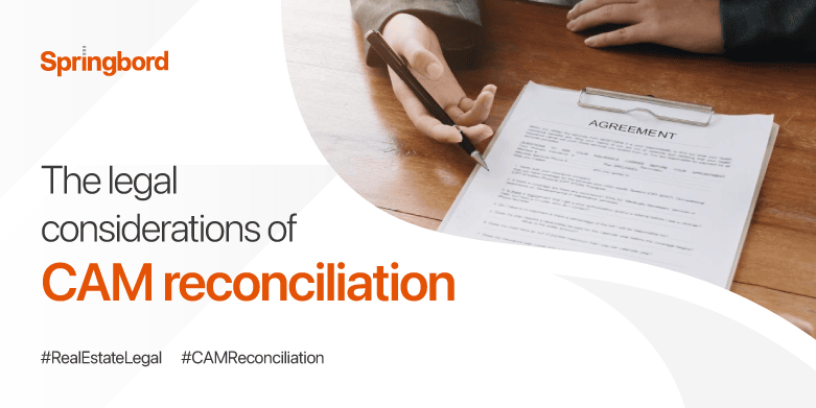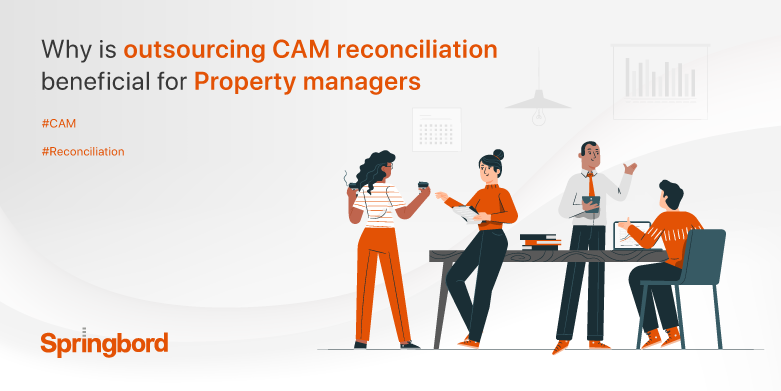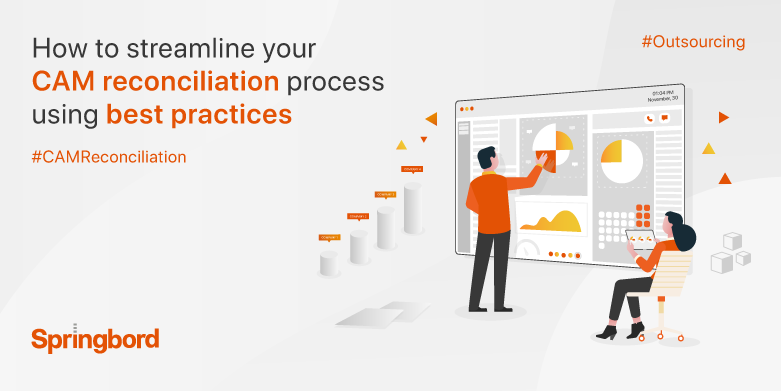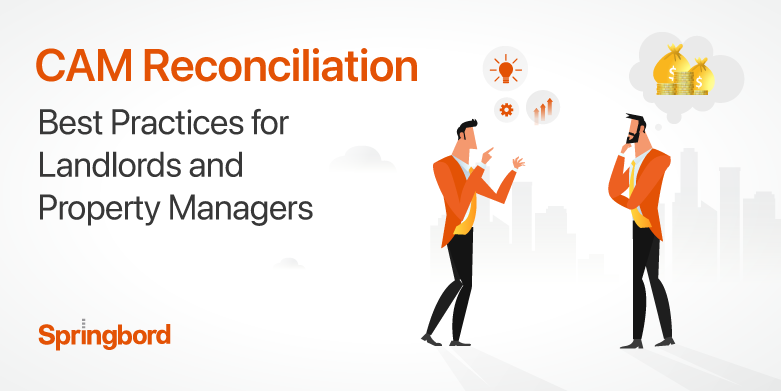 Read time 8 min
Read time 8 minLegal considerations of CAM reconciliation are of the utmost importance in commercial property management. Common Area Maintenance (CAM) reconciliation refers to balancing expenses between proprietors and tenants for shared property areas.
To ensure impartiality, transparency, and compliance with lease agreements, it is vital to comprehend and adhere to the legal aspects governing this reconciliation process.
This article highlights the pivotal role of legal considerations of CAM reconciliation, emphasizing their impact on lease relationships and property management practices.
The Legal Framework for CAM Reconciliation
A thorough understanding of the legal considerations of CAM reconciliation is essential for successful commercial property management.
Adherence to relevant laws and regulations, careful analysis of lease agreements, and proactive efforts to prevent and resolve disputes can foster a harmonious and mutually beneficial relationship between landlords and tenants.
A. Overview of Relevant Laws and Regulations Governing CAM Reconciliation
CAM reconciliation is a critical process that involves allocating expenses between landlords and tenants for the upkeep and maintenance of shared areas in a property.
A complete legal structure governs this procedure to ensure compliance with justice, transparency, and leasing agreement.
To minimize disagreements and potential litigation, it is crucial for all parties participating in CAM reconciliation to understand the legal considerations of CAM reconciliation.
Federal, state, and municipal statutes, rules, and recommendations constitute the legal foundation for CAM reconciliation. Different types of properties, such as shopping malls, office buildings, and factories, may be subject to various regulations.
For instance, in the United States, landlord-tenant legislation, real estate regulations, and lease requirements can vary from state to state, making CAM reconciliation difficult.
B. Analysis of Lease Agreements and Their Impact on CAM Reconciliation
The lease agreement heavily influences the CAM reconciliation procedure. Landlord and tenants must fulfill specific duties and responsibilities under the terms and conditions outlined in the lease agreement. Leases typically contain stipulations detailing CAM expenses, reconciliation intervals, and cost allocation methodologies.
The legal considerations of CAM reconciliation in lease agreements include the following:
- CAM Expense Inclusion: Lease agreements should explicitly state which are considered CAM expenses and whether certain costs are excluded from reconciliation.
- Reconciliation Frequency: The lease should specify the frequency of CAM reconciliation, for example, annually, quarterly, or semiannually.
- Calculation Methods: The lease should specify how CAM charges are to be computed, be it on a per-square-foot basis, a flat rate, or some other cause.
- Documentation Requirements: Lease agreements typically require the landlord to provide the tenant with complete CAM spending reports and supporting documentation.
C. Disputes and Litigation Related to CAM Reconciliation Issues
Despite efforts to create comprehensive lease agreements and adhere to legal considerations, disputes related to CAM reconciliation may still arise. Conflicts arise from parties’ divergent interpretations of lease provisions, disputes over who should pay for what, or charges of erroneous expense estimations.
Resolving disputes through negotiation or mediation is often the preferred approach, as it allows parties to maintain a working relationship while finding a middle ground.
However, disputes can quickly turn out of hand, necessitating the involvement of the law. Complex and time-consuming litigation may arise from CAM reconciliation concerns, necessitating an in-depth analysis of lease agreements, financial documents, and property management procedures.
Key Legal Considerations in CAM Reconciliation
Adhering to vital legal considerations in CAM reconciliation is essential for promoting compliance, fairness, and harmonious relationships between landlords and tenants.
A successful and legally sound CAM reconciliation procedure is predicated on proper documentation, transparency in spending and calculations, lease compliance, and effective dispute resolution processes.
A. Proper documentation and record-keeping requirements
Accurate and complete documentation is one of the most essential legal factors in CAM reconciliation. The building’s owners or managers must carefully track all maintenance costs for shared areas.
Invoices, receipts, and any supporting documentation for money collected from tenants. Correct documentation not only guarantees openness but also provides critical evidence in audits and legal issues.
The collection of receipts is only one part of meeting record-keeping requirements. It entails putting the paperwork where it can be easily found and accessed.
Secure data management practices are essential for property managers to protect tenants’ private financial data and make such data easily accessible for tenant audits and government inspections.
B. Ensuring transparency in CAM expenses and calculations
Effective CAM reconciliation relies heavily on open communication. Owners and managers of rental properties owe it to their renters to be forthright when discussing CAM costs and how they are determined.
To help tenants better understand the rationale for the charges, landlords should provide itemized lists of expenses, including maintenance, repairs, utilities, and administrative costs.
Additionally, clear and concise explanations of the reconciliation process are essential. Reconciliation procedures, the mechanism used to allocate costs, and any modifications to either should be communicated to tenants.
Transparent communication fosters trust between parties and minimizes the risk of disputes arising from misunderstandings or perceived lack of clarity.
C. Compliance with lease terms and legal obligations
Landlords and tenants must follow the lease agreement rules, the contractual basis for CAM reconciliation. The frequency of CAM reconciliation permitted spending categories and the formula for expense allocation are all items that the landlord should specify in the lease.
Tenants are also responsible for making timely CAM payments as required under the lease. Breach of contract claims and other legal challenges may come from tenants’ failure to abide by the lease’s stipulations. Legal counsel should review and negotiate the lease terms for both parties to ensure they are legal, reasonable, and fair.
D. Handling tenant disputes and grievances regarding CAM charges
Landlords and tenants may have disagreements and disputes concerning CAM charges despite best efforts. Owners and managers of rental properties owe tenants a duty of timely and courteous attention whenever tenants voice complaints. Keeping channels of communication open is critical for resolving problems before they escalate.
Litigation is expensive and time-consuming; any disagreement that can be settled out of court should be. Parties can resolve their differences amicably outside of court using a structured strategy like mediation or arbitration.
If property managers want to keep their tenants happy and the CAM reconciliation process honest, they need to implement strategies for resolving tenant complaints that are fair and transparent.
Mitigating Legal Risks in CAM Reconciliation
Mitigating legal risks in CAM reconciliation requires landlords and property managers to implement best practices, maintain transparency, and foster effective communication with tenants.
A. Best practices for landlords and property managers in CAM reconciliation
Landlords and property managers can reduce their exposure to legal action by following best practices for CAM reconciliation that emphasize openness, compliance, and clear communication. These practices include:
- Clear and Comprehensive Lease Agreements: Well-written leasing agreements should detail CAM reconciliation processes, expenditure types, and computation techniques. As a result, there is less room for interpretation, and interpretation-based disputes about the lease terms are reduced.
- Accurate Expense Documentation: Precise documentation of expenditures, including invoices and receipts, for all CAM expenditures. In the event of a disagreement or audit, having detailed records to back up your spending allocations is essential.
- Regular Reconciliation Timelines: Establish regular reconciliation timelines and inform tenants of these plans. Avoiding surprises and showing dedication to fair practices both benefit from regular reconciliation.
- Reviewing Expense Allocations: Expense allocations should be reviewed and validated regularly to ensure fairness and align with the lease’s requirements. Get to the bottom of any differences immediately and openly.
B. Strategies to prevent potential legal disputes related to CAM charges
Maintaining good tenant relations and avoiding expensive litigation can be significantly aided by preventing legal conflicts over CAM charges. Some strategies to minimize these risks include:
- Proactive Lease Reviews: Proactive lease reviews are conducted regularly to ensure that lease agreements are by current laws and industry norms, as advised by legal advice. Find possible points of contention and resolve them in advance.
- Open Dialogue: Promoting transparent communication between landlords and tenants regarding CAM fees and reconciliation procedures. Avoiding further escalation of disputes requires fast attention to concerns and clarifications.
- Compliance Audits: Conducting compliance audits regularly to ensure that CAM reconciliation procedures align with lease agreements and laws is step three. Disagreements can be avoided if problems are found and fixed immediately.
C. The role of mediation and arbitration in resolving CAM reconciliation conflicts
When disputes do arise, mediation and arbitration play essential roles in resolving CAM reconciliation conflicts outside the courtroom:
- Meditation: Mediation is a form of alternative dispute resolution in which a neutral third party (the mediator) helps the disputing parties talk things out to establish areas of agreement and work out a compromise. Tenant-landlord relationships can be preserved and even strengthened through the mediation process.
- Arbitration: Arbitration has an unbiased arbitrator examine the facts and conclude that it is enforceable in law. Disputes can be resolved quickly and inexpensively through arbitration than the court system.
Trends in CAM Reconciliation Regulations
The trends in CAM reconciliation regulations will likely drive substantial changes in the commercial property management landscape.
A. Potential changes in the legal landscape of CAM reconciliation
The regulatory framework for CAM reconciliation is subject to change as time goes on, just like the commercial property business itself. One possible shift is towards more consistent and standardized CAM reconciliation procedures.
The reconciliation process may be streamlined and disparities reduced if policymakers and business groups work together to establish uniform principles or best practices.
There may also be a shift towards protecting tenants more strongly. To ensure tenants fully understand the charges they incur, regulatory organizations may establish steps to increase transparency in CAM expenses and set tougher criteria for paperwork.
As a result, landlords may face increasing scrutiny, calling for greater transparency and liability.
B. Anticipated developments in laws and regulations
New legislation and guidelines may be developed to deal with specific difficulties and new problems in CAM reconciliation.
Technology in reconciliation procedures, such as digitizing paperwork and adopting automated expense tracking systems, may be subject to rules and laws. The proposed regulations would strengthen data security, accuracy, and efficiency.
Sustainable and environmentally friendly practices may also find their way into CAM reconciliation. Governments and environmental authorities may incentivize or mandate eco-friendly efforts in community areas, and rules may emerge to ensure accurate accounting and equitable distribution of expenses.
C. Implications for commercial property stakeholders
The evolving regulatory landscape will undoubtedly impact commercial property stakeholders in various ways. If building owners and managers want to keep their CAM reconciliation methods legal, they must keep up with ever-evolving rules.
They may also need to invest in cutting-edge technological solutions to fulfill the increased reporting and documentation standards effectively.
Tenants may have a better starting point for lease negotiations if future regulations increase transparency and clarity regarding CAM charges. Tenants who are aware of the best practices for CAM reconciliation may prefer to lease space from landlords who prioritize openness and honesty in allocating CAM costs.
Furthermore, these statutory shifts may affect landlord-tenant talks regarding the distribution of CAM costs. Due to shifting industry norms, tenants may have more bargaining power when renegotiating lease terms. At the same time, property owners may need to account for compliance costs and technological upgrades when setting CAM rates.
To Sum Up
The legal considerations of CAM reconciliation play a pivotal role in ensuring fair and transparent commercial property management practices. A successful CAM reconciliation procedure requires adherence to applicable laws and regulations, precise documentation, and resolution of tenant disputes.
Businesses trying to make their way through the difficulties of this field would be well to form partnerships with established service providers like Springbord.
The innovative Internet-based capabilities used by Springbord, a prominent worldwide information service provider, allow the company to provide outstanding business process outsourcing services to various industries.
Increased public and private sector client confidence and trust can be gained with the help of Springbord’s CAM reconciliation processes, which are both efficient and compliant.







